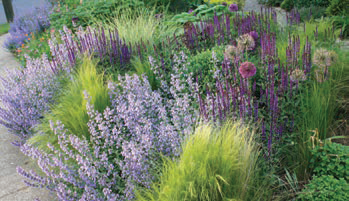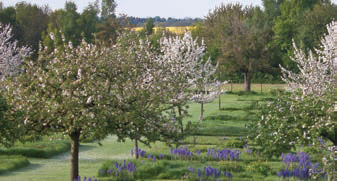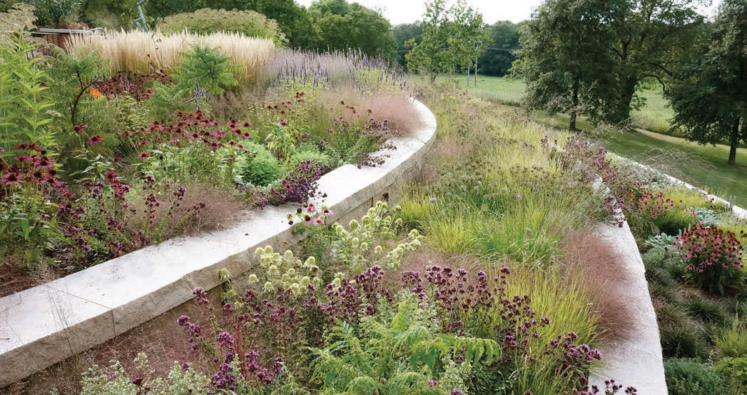Renowned designer, plantsman and water garden specialist, Gordon Ledbetter shares his thoughts on the recent GLDA design seminar
The Garden and Landscape Designers Association (GLDA) held its 19th consecutive seminar on 7 February at the Crowne Plaza, Northwood, Dublin 9. By general consent it was one of the best seminars held in many years and one of the largest with more than 200 attendees, including at least eight from Holland and two who had travelled from as far afield as the United States; and with the speakers chosen from Ireland, England, France and the USA, the seminar was truly an international event. Not all events of this kind by any manner of means run to time or run smoothly. Chairman Gary Foran and Council, and Administrator Annette McCoy are to be congratulated on their admirable efficiency. There was an upbeat feel to the event reflecting perhaps that the Irish economy is on the move again, besides which the chosen theme seemed of universal interest: ‘The New Perennial Movement: Transient Trend or Adaptable Style?’ Ideally, you would have four speakers each with their own distinctive take on the subject and that was exactly what we got.
Verney Naylor, a founder member of the GLDA, is a well known and much-admired designer of gardens large and small throughout Ireland. The title of her lecture was Horizons –finding inspiration from beyond the garden gate. She looked to her travels in order to garner ideas that might be used in the garden design. She had images from several continents and contrasting terrains. Verney was emphatic that perennials are less successful on their own than with shrubs and trees. You need both and you need accents of height as well as spread. The Canadian prairies are the kind of thing to avoid, all flatness and no relief. Similarly, Verney dislikes unrelieved concrete ribbons around houses with no planting – again height and spread should be sought. Bamboos she loves for their movement, ferns are nearly always incorporated in her planting schemes and she favours allowing wild plants within reason to colonise available spaces and mingles with the set plants. Verney does not eschew common or garden plants, such as Alchemilla mollis and favours Myrtus communis subsp. tarentina for low hedging. While the borrowed scenery is greatly admired by the Japanese, it is hardly exploited in Ireland, but Verney seeks it wherever possible and showed us fine examples of gardens where distant views were drawn into the scheme. Above all, perhaps what is outstanding about Verney’s designs is how natural they appear, the art that conceals art, the enviable ability of a designer who can make the natural garden look ‘as if it had always been there.’
From Normandy husband and wife team Patrick and Sylvie Quibel (with able translation by M. Tanguy de Toulgoët) brought us through the history of, and dramatic seasonal changes at their garden in Le Jardin Plume – Comment composer avec la Nature. Composing with nature, yes, but with a rigorously formal, quintessentially

French layout. Made from an old orchard, fruit trees now provide vertical accents in serried ranks the length of central section of the garden which consists of a closely mown crisscross of paths and 8m square panels of higher grass in which spring bulbs and perennials are displayed sequentially. At the house end, what might be described as a box parterre with open middle sections, directs the eye towards a pond the same size as, and in line with the planting squares. A powerful focal point, in all seasons and moods the brimming water draws the big Normandy skies into the garden. In spring delightful apple blossom and dappled shade beneath are complemented by blue camassias followed by white. Nearest the house hot colours of red, orange and yellow perennials ‘erupt’ from the parterre. ‘Like a firework display,’ in the words of one visitor, ‘magic.’ The borders to the sides of the garden are planted with drifts of grasses and cooler perennials, including Fililpendula, Thalictrum, Aquilegia and the ethereal Sanguisorba tenuissima ‘Alba’. Varieties of Miscanthus and Calamagrostis feature prominently, including the ghostly white plumes of M. “Saturnia”, bred by the Quibels. These grasses give the garden its name Le Jardin Plume (Feather Garden, although it is much more than that). Asters, including Aster ericoides and Phlox, provide colour in autumn. The effects the owners seek are not firm blocks of colour nor even just intermingling of plants, but rather sparkles of different colours akin to pointillist painting and with a palette equally elaborate. The Quibels save their own seed to sow as plugs, thus constantly replenishing and re-balancing the planting. A striking feature for all seasons is a perimeter box hedge on one side, cut meticulously into concave, curling waves of varying sizes. This is a high maintenance garden of remarkable originality, kept to the highest standards.
Keith Wiley’s lecture was well titled: ‘On the wild side – an experiment in new naturalism.’ As head gardener at The Garden House on the edge of Dartmoor, he developed it into a landmark site for naturalistic planting, then decided to go it alone in 2004 to create his own aptly named Wildside Nursery and Garden, near Yelverton, Devon. Beginning with a plain, slightly sloping site of four acres, Keith set about reshaping it, creating hills and miniature gorges, in the process turning, he reckons, the four acres into six. The site was transformed, providing new habitats and mini microclimates. All this suited his approach to gardening as ‘enhanced nature’, creating the illusion of a natural landscape. In introducing countless plants from his extensive travels, with a predilection for the Swiss Alps, Keith takes pains matching plants with the most suitable habitats, blending grasses and perennials to maximum natural effect. ‘I am flowerer junkie’ he says with relish, being sensitive both to colour and architectural shapes. An unusual feature of Wildside is how he took the time and trouble to borrow not scenery but the sun! For 15 minutes the sun passes between trees and over rocky outcrops at specially created spots filled with grasses that become radiantly iridescent when backlit by the setting sun, a beautiful scene redolent of a carefully designed stage set.

Landscape architect, writer and teacher from Washington DC, Thomas Rainer, in ‘The New Perennial Movement: Exhausted or Just Getting Good?’ took us through the development of the perennial movement. He went back as far as our own William Robinson, and showed examples, from among others, of the work of his former employer, the late James van Sweden, whose style of swathes of interlocking blocks of plants (the antithesis to Verney Naylor’s approach using groups sparingly) have given way to the current fashion for a more natural style of perennials and grasses intermingling. So where might the perennial movement go from here? Thomas offered a word of warning, quoting Michael King: “Now that the Dutch Wave has been renamed all we are left with is the look. New Perennial
Planting has become pan-global with the same formula, using the same “new” plant assortment, being trotted out over and over again. Its success is fuelled by the sheer beauty of the plants it contains, but its integrity has been lost – leaving us with just another style of decorative planting.” An ironically amusing image of a ‘Yard of the Month’ – a piece of real estate advertising – showed how sterile urban landscaping can be and still be admired by some. But not as sterile as some urban conurbations illustrated with aerial photographs, which were seemingly devoid of all greenery. In an arresting phrase, Thomas Rainer made a plea for ‘the re-wilding of America’ and by the same token for greater use of native species. That’s the only hope of maintaining and in so many instances re-establishing the relationship between flora and fauna. Ask the birds and bees – and ultimately ourselves. ✽






